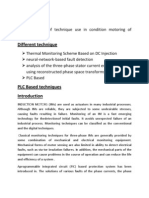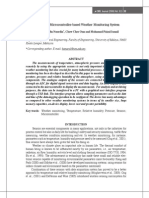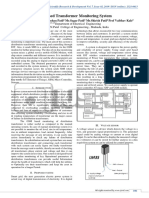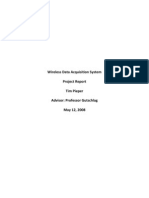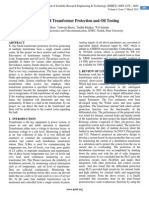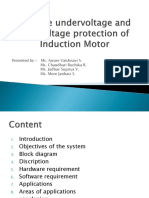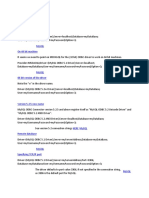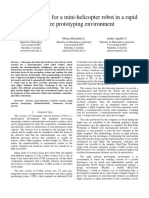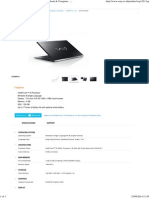Engine Status Monitoring System Using Real Time Clock (ds1307)
Engine Status Monitoring System Using Real Time Clock (ds1307)
Copyright:
Available Formats
Engine Status Monitoring System Using Real Time Clock (ds1307)
Engine Status Monitoring System Using Real Time Clock (ds1307)
Original Title
Copyright
Available Formats
Share this document
Did you find this document useful?
Is this content inappropriate?
Copyright:
Available Formats
Engine Status Monitoring System Using Real Time Clock (ds1307)
Engine Status Monitoring System Using Real Time Clock (ds1307)
Copyright:
Available Formats
International Journal of Computational Engineering Research||Vol, 03||Issue, 5||
Engine status monitoring system using real time clock (ds1307)
Manjunath Managuli1, Yogeshkumar M H2
1 2
PG Scholar, VTU Extension Center UTL Technologies Ltd, Bangalore-22 Assistant Professor Vivekananda Institute of Technology Bangalore-77
Abstract:
In this paper Engine status monitoring system (Block box) is used as a safety equipment to store the all data information of Railway engine WAP7 with real time data and time .Here we can use various types of sensor for measuring parameters of electrical engine and also store voice recorder with the system for safety and investigation of accidents. This system is controlled by ATMEGA 328P controller. The device stores all the data information up to 24 Hrs recording capability with real data and time this system operates at 5-12volt with 3amps current rating and all the recorded data of memory can be retrieved by hyper terminal of PC or Laptop.
Keywords: - Controller (ATMEG 328P), Engine Status Monitor (ESM), Real time Sensor. I. INTRODUCTION
In this paper we are using some of the sensors those are essential components in some applications in daily life far building &security monitoring and whether condition monitoring etc. And also used in the industries for process control .In engine monitor system we sense the sum of parameters such as temperature, vibration air flowing BP and FP. Wheel sleep speed , breaking pressure and vigilance using sensors railway engine play an important role for proper operation of railway. Railway electrical consist various analog and digital device.[1.2]. Indian railway operate on gigantic dimension covering 463000 kilometers with daily landing of 1.6 million times of fright and daily transporting of 14 million passengers by lagging more than 4 million train kilometers/day .Indian railway gives highest priority for safest means of transportation for public no comprises tolerated in safety of railway users and all levels of management keep resolving safety performance from time to time [3.8] in engine status monitoring is proposed for safety equipment to store all the data of railway engine WAP& and also voice recorder is used with this system to investigation of accidents and safety of railway engine . This paper builds with a low cost reliable engine status monitoring system capable of acquiring and recording data. The system has 9 sensors that measure temperature, wheel sleep air flow in BP and FP, breaking pressure speed, vibration direction vigilance and voice of the pilots these sensors include analog and digital data the analog data converted in to digital form using analog to digital converter for further processing the logged data can be transfer to pc. For further analysis of measurements.
Fig 1. Black diagram of EMS
www.ijceronline.com
||May ||2013||
Page 12
Engine status monitoring system using real time clock (ds1307)
II.
ENGINEE STATUS MONITORING SYSTEM
The system is divided into four main parts, namely, the sensor circuit, the data logging circuit, the time keeping circuit and the serial interfacing circuitry. The sensor circuit contains the IC temperature sensors, pressure sensor, voice sensor, airflow sensor, wheel slip sensor, vigilance sensor. A part from temperature and pressure sensor each sensor have digital output. The analog data of temperature and pressure sensor is converted into digital signal by ADC before being fed into the data logging circuit which encompass a controller. The current time for data logging purpose is provided by the time keeping circuit using real time IC while the serial interfacing circuit facilities the data transfer between the data logger and PC. The internal and external architecture of the present system is depicted in Fig. 2.
Fig. 2: External and Internal Architecture of the system 2.1. The sensor circuit For temperature sensing, an integrated circuit temperature sensor LM 35 is used. The output voltage of the sensor is linearly proportional to the temperature (in Kelvin or Celsius) with the gradient of 10mV/C and able to operate in the range of - 55C to 150 C. As the device is to be used in electric engine where the temperature range in between 0C to 70C. The braking pressure measurement is performed by the barometric pressure sensor, MPX4115A. Its output voltage in the range of 0.2 to 4.8V is linearly translated into pressure measurement of 15KPa to 115KPa. [9] This sensor is also compensated from -40C to 125C, thus suitable to be used with this system. Measurement of train vibration is done by smart sensor based on variable capacitance theory. The output of this sensor is in the form of frequency having the range 0 Hz to 64 KHz. [10, 11] for speed and airflow measurement MOC7811 sensor used which provide output in the form of frequency. For sensing of voice of pilot and copilot electorate type microphones are used with melody controller ATMEG 328P. [12] An ADC performs the conversion of all analogous outputs from the sensors into digital signal to be fed to the controller. Amplification and offset adjustment (as in temperature sensor) of these signals are provided by the LM 358 operational amplifier. Although amplification is necessary to suit the input range of the ADC, noise from sensors is also amplified. To alleviate this problem and to maintain consistency of the sensing system, a noise filtering circuit is added before the operational amplifier. Fig.3 shows the various sensors used in the present system.
Fig. 3: sensors used with ESM
www.ijceronline.com ||May ||2013|| Page 13
Engine status monitoring system using real time clock (ds1307) 2.2. Data logging circuit The main component here is the ATMEG 328P controller, which is equipped with 8KB of flash memory and 0- 24MHz processing speed. This controller not only controls the system but also synchronizes all the module operation. An EEPROM with 1024 KB capacity is connected to the controller for storing the sensors reading up to eight hours (for 30 second sampling interval) the interfacing of the EEPROM and controller is based on the I2C bus. The I2C bus provides a simple bi- directional 2 wire bus for efficient inter IC control. An LCD module is also connected to the controller to display the measurement of the sensors and the current time. The data logger also allows the user to browse through the recorded data and change the sampling interval. Fig. 3 shows the interfacing card of the present system. 2.3. The time keeping circuit A real time clock (RTC) chip is employed for time keeping purpose. Communication between the chip and the controller is achieved via a simple serial interface. The time will be displayed on the LCD. A separate battery source supplies the power required by the chip hence enables its operation kept undisturbed in the event of main power sources failure. 2.4. The interfacing circuit and the HyperTerminal Data stored into EEPROM can be accessed directly with a personal computer (PC) through serial interface RS -232. This connection established via a serial interfacing IC named MAX 232. The recorded data is retrieved by using HyperTerminal of Laptop or computer.
Fig. 4: Interfacing card of the system
III.
HARDWARE AND SOFTWARE SPECIFICTION
The internal and external layout of black box is depicting in fig. 2. This circuit diagram is consist of sensor unit (SU), crash survival memory unit (CSMU), engine data acquisition unit (EDAU), Display Unit(DU), Retriever unit(RU), Real time unit (RTU), power supply unit (PSU). Basically the memory unit is proposed to fit inside the crash survival shell which can tolerate the Crash impact, Pin drop, Static crush, Fire test, Deep-sea submersion, Fluid immersion and Salt-water submersion tests. In black box data from various parameters is collected in electric signal from using sufficient sensors. These electrical signals are in analog or digital form. If signals are digital then these signals directly applied to the controller and if the signals coming from sensor is analog the firstly it converted into digital form using ADCs. Almost WAP-7 engine are digitalized and the digital data of electric engine can be directly taken and send to the microcontroller. Controller processes the data of sensors with real date and time using RTC DS1307 and records it into external memories. This recorded data display on 16 X 2 LCD. The information of recorded data retrieved using hyper terminal of computer and switching device. The controllers are programmed in C language using Kiel compiler. The simulations of the circuits are further tested by Protinus software after that they designed for the system. The layout formation of the circuits has done by Orcad software. [13]
3.1. Technical specification 1. Power supply - +5V, +12V 2. Operating frequency 50Hz 3. Current 3A 4. Power consumption 2.6A 5. Recording capability 12 hrs 6. Temperature range 0-70C 7. Sampling time- 15 seconds 8. Vibration Frequency 0 to 64 KHz 9. Speed Sensor range 2000RPM 10. serial interface with PC
www.ijceronline.com
||May ||2013||
Page 14
Engine status monitoring system using real time clock (ds1307)
IV.
INTERGRATION
In the present system sensor unit is proposed to attached with their respective parameters in the cabin desk of engine as shown in fig. 4 at point A speed sensor, point B airflow sensor, at point C throttle positing sensor, at point D vigilance, at point E wheel slip sensor are proposed to placed. Temperature, vibration and voice sensors are used at multiple sensitive places of engine.
Fig. 5: loco pilot cabin of WAP-7 engine
V.
CONCLUSIONS AND RESULT
In the present work a engine status monitoring system (black-box) is designed for railway electric engine WAP-7. This system is an application of sensor technology and embedded system. This black-box is useful for recording the status of engine with respect to read date and time for getting the real status of engine and its sensitive apparatus during its operat ing period. In away when any type of accident occurs due to any reason. It provides necessary data to generate the report of accident and about its causes. The recorded data of parameters are easily transferred to hyper terminal of laptop/ computer with real date and time. Thus it provides help to monitor the status of several parameters of electric engine which are responsible for proper movement of railway engine. Cabin voice data recorder also gives the important clues about accident. With the help of this device investigation team get the required data for reach the conclusion whether this accident occurs due to equipment failure of or due to human error and taking appropriate decision.
REFERENCES
[1]
[2] [3] [4] [5] [6] [7] [8] [9] [10] [11] [12] Alka Dubey & Ashish Verma, Design & Development Of Black Box For Railway Electric Engine WAP-7, proceedings of fourth M.P. Science Congress,(2007) pp 40-49. Alka Dubey & Ashish Verma, A Engine Data Recorder (Black Box) For Railway Eelectric Engine, proceedings of International railway safety conference, (2007) pp98-99. White Paper Safety on Indian Railways, (2009) Govt. of India, Ministry of Railways. Agarwal Amitabh, Rail Accidents due to Human Errors- Indian Railways Experience, International Railway Safety Conference, (2005) Cape Town, South Africa. Indian Railways Corporate Safety Plan, (2003) Government of India, Ministry of Railways. Amitabh Agarwal, Director (safety), Ministry of Railways, Government of India, (2007) Human Interface in Railway Safety A New Dimension, http://panko.cba.hawaii.edu /humanerr/Theory.htm. Amit Kumar, P.K.Sinha, Human Error Control in Railways, (2008) Jordan Journal of Mechanical and Industrial Engineering Volume 2, Number 4, December. pp183 190. P. C. Sharma, Safety as Key Business Theme! - Indian Railways Perspective, Proceedings of international railway safety conference, (2004), pp 1 19. Kamarul Ariffin Noordin et al, a low cost microcontroller based weathe monitoring system, CMU J. (2006) Vol 5(1), pp 33-39. Alka Dubey & Ashish Verma, vibration sensor with wireless communication for recording and analyzing train vibration. Fourth international conference of WCSN, IEEE, (2008) pp 203-205. Alka Dubey and Ashish Verma, Smart Sensor for Analyzing Train Vibration in WCR Zone, Sensors & Transducers Journal, (2009) Vol. 108, Issue 9, pp. 1-7. Alka Dubey & Ashish Verma, Design & Development of a Wireless Sensor Network for Transferring the Data from Electric Engine to Passing Railway Station for Vigilance Purpose. Al-Falah s journal of science and technology, (2009) vol1, no 3, pp188-190.
www.ijceronline.com
||May ||2013||
Page 15
You might also like
- SOASuite12c Tutorial PDFDocument392 pagesSOASuite12c Tutorial PDFSatyendra Talatam83% (6)
- Siemens ScadaDocument12 pagesSiemens ScadaAnonymous 5cMeyYyxhNo ratings yet
- Wireless Speed Control of DC Motor Using PWM and UARTDocument3 pagesWireless Speed Control of DC Motor Using PWM and UARTElins Journal100% (1)
- AEM4Document7 pagesAEM4dhaval2430No ratings yet
- Real - Time Envirnorment Monitoring System and Data Logger Using Arm ProcessorDocument5 pagesReal - Time Envirnorment Monitoring System and Data Logger Using Arm ProcessorInternational Journal of computational Engineering research (IJCER)No ratings yet
- Adaptive Traffic Light Control SystemDocument15 pagesAdaptive Traffic Light Control SystemSadaf TajNo ratings yet
- RPM IndicatorDocument39 pagesRPM IndicatorAnkur PatelNo ratings yet
- Track1 1570688080Document5 pagesTrack1 1570688080satria cantaputraNo ratings yet
- DC Motor System Identification and Speed Control Using dSPACE ToolsDocument14 pagesDC Motor System Identification and Speed Control Using dSPACE ToolsIhab BenayacheNo ratings yet
- Accelerometer Based Gesture Recognisation For Wheel Chair Direction Control Using ZIGBEEDocument5 pagesAccelerometer Based Gesture Recognisation For Wheel Chair Direction Control Using ZIGBEEeditor_ijtelNo ratings yet
- Direct Digital Control: Om Prakash BhartiDocument5 pagesDirect Digital Control: Om Prakash Bhartivictor alfonso campechano venturaNo ratings yet
- A Low-Cost Microcontroller-Based Weather Monitoring System-LibreDocument8 pagesA Low-Cost Microcontroller-Based Weather Monitoring System-LibreRohit PatilNo ratings yet
- Data Procurement and Control Associated Online SystemDocument5 pagesData Procurement and Control Associated Online SystemseventhsensegroupNo ratings yet
- IJSRDV7I20141Document4 pagesIJSRDV7I20141aadiprojects9081No ratings yet
- Low Cost PC Based Real Time Data Logging System Using Pcs Parallel Port For Slowly Varying SignalsDocument7 pagesLow Cost PC Based Real Time Data Logging System Using Pcs Parallel Port For Slowly Varying SignalsSindhu VelayudhamNo ratings yet
- Microprocessor Based Digital PID Controller For Speed Control of D.C. MotorDocument6 pagesMicroprocessor Based Digital PID Controller For Speed Control of D.C. MotorSwapnica GarreNo ratings yet
- Research Inventy: International Journal of Engineering and ScienceDocument10 pagesResearch Inventy: International Journal of Engineering and ScienceresearchinventyNo ratings yet
- Mechatronics 18 NovDocument10 pagesMechatronics 18 NovEsnayder teorias dragon ballNo ratings yet
- Design and Implementation of Motor Speed Control and Temperature Sensing Unit Using PIC ControllerDocument4 pagesDesign and Implementation of Motor Speed Control and Temperature Sensing Unit Using PIC Controllerijsret100% (1)
- Wireless NetworkingDocument4 pagesWireless Networking8197406481No ratings yet
- 6-Iriset S28 PDFDocument109 pages6-Iriset S28 PDFAnjaliTripathi75% (4)
- Design and Implementation of A Digital TachometerDocument3 pagesDesign and Implementation of A Digital TachometerInnovative Research Publications0% (1)
- Review of Remote Terminal Unit RTU and Gateways FoDocument5 pagesReview of Remote Terminal Unit RTU and Gateways FoEng Said MohammedNo ratings yet
- Design and Implementation of Wireless Energy Meter System For Monitoring The Single Phase SupplyDocument4 pagesDesign and Implementation of Wireless Energy Meter System For Monitoring The Single Phase SupplyReeta DuttaNo ratings yet
- Direct Digital ControlDocument6 pagesDirect Digital Controlkevindavies276No ratings yet
- Eng-Design of Open Architecture Ship-M.S. ZaghloulDocument18 pagesEng-Design of Open Architecture Ship-M.S. ZaghloulImpact JournalsNo ratings yet
- 1.ourside - Vip.automatic Temperature Control and Alert System Simulation and design.2207ELX019Document9 pages1.ourside - Vip.automatic Temperature Control and Alert System Simulation and design.2207ELX019ssNo ratings yet
- Speed Monitoring and Protection of Motor Using Zigbee CommunicationDocument7 pagesSpeed Monitoring and Protection of Motor Using Zigbee CommunicationijsretNo ratings yet
- Automated Data Acquisition System For Microwave BeDocument4 pagesAutomated Data Acquisition System For Microwave Beppg.sitiistiqamah99730No ratings yet
- WiDAS - Final ReportDocument39 pagesWiDAS - Final ReportAamir Hasan KhanNo ratings yet
- Touch Screen and Accelerometer Based Wireless Motor Speed and Direction Controlling System Using ArduinoDocument4 pagesTouch Screen and Accelerometer Based Wireless Motor Speed and Direction Controlling System Using ArduinoseventhsensegroupNo ratings yet
- 99 000 RPM Contact Less Digital TachometerDocument11 pages99 000 RPM Contact Less Digital TachometerHemanth Kumar K SNo ratings yet
- Shi-Ai Ren, Hong-Wu Chen, Hai-Peng Zhang, Zhu Liu & Shan-Shan WuDocument6 pagesShi-Ai Ren, Hong-Wu Chen, Hai-Peng Zhang, Zhu Liu & Shan-Shan WuselvakumargeorgeNo ratings yet
- Metering Manual - PgcilDocument93 pagesMetering Manual - PgcilKrishna Venkataraman100% (1)
- Multichannel Data Acquisition SystemDocument11 pagesMultichannel Data Acquisition SystemIJRASETPublicationsNo ratings yet
- Development of Coalmine Safety System Using Wireless Sensor NetworkDocument10 pagesDevelopment of Coalmine Safety System Using Wireless Sensor Networkchinu07416No ratings yet
- Internet of Things Based Real Time Transformer Health Monitoring SystemDocument4 pagesInternet of Things Based Real Time Transformer Health Monitoring SystemDhaneeshNo ratings yet
- Safety Auto Brake System For Vehicles in Hill Station Using Mems SensorDocument7 pagesSafety Auto Brake System For Vehicles in Hill Station Using Mems Sensorskvj0211No ratings yet
- XBEE Based Transformer Protection and Oil TestingDocument3 pagesXBEE Based Transformer Protection and Oil TestingijsretNo ratings yet
- A Review On Smart Ambulance With Traffic Control Using Wireless TechnologyDocument24 pagesA Review On Smart Ambulance With Traffic Control Using Wireless TechnologymanuNo ratings yet
- Data Acquisition System For A Formula SAE Race CarDocument43 pagesData Acquisition System For A Formula SAE Race CarRodrigo Bob100% (1)
- Micro Controller Based School TimerDocument5 pagesMicro Controller Based School Timera_kureelNo ratings yet
- Unit 6Document77 pagesUnit 6shindekartik43No ratings yet
- BLDC Sinusoidal ControlDocument6 pagesBLDC Sinusoidal ControlOctavian MîrţiNo ratings yet
- Ch8 VIDocument42 pagesCh8 VIAdhiraj C ChoudharyNo ratings yet
- 2.microcontroller Based Transformer Health Monitoring System Using IotDocument38 pages2.microcontroller Based Transformer Health Monitoring System Using IotDinesh KumarNo ratings yet
- Design of The Data Acquisition System Based On STM32: Information Technology and Quantitative Management (ITQM2013)Document7 pagesDesign of The Data Acquisition System Based On STM32: Information Technology and Quantitative Management (ITQM2013)Josue Manuel Pareja ContrerasNo ratings yet
- Automatic Speed and Torque Monitoring in Induction Motors Using Zigbee and SmsDocument6 pagesAutomatic Speed and Torque Monitoring in Induction Motors Using Zigbee and SmsRaghul RamasamyNo ratings yet
- Ms. Aware Vaishnavi S. Ms. Chaudhari Ruchika R. Ms. Jadhav Supriya V. Ms. More Janhavi SDocument12 pagesMs. Aware Vaishnavi S. Ms. Chaudhari Ruchika R. Ms. Jadhav Supriya V. Ms. More Janhavi SSagar JamkarNo ratings yet
- IOT Based Low Cost Blood Pressure Monitoring System Using LPC 2148Document16 pagesIOT Based Low Cost Blood Pressure Monitoring System Using LPC 2148Pratima ChavanNo ratings yet
- Speed Control of Single Phase Induction Motor Using Infrared Receiver ModuleDocument6 pagesSpeed Control of Single Phase Induction Motor Using Infrared Receiver ModuleSanjay ShelarNo ratings yet
- Implementation of GSM Based Heart Rate and Temperature Monitoring SystemDocument7 pagesImplementation of GSM Based Heart Rate and Temperature Monitoring SystemPriyanka BujugundlaNo ratings yet
- Econv Trans 97 - Continuous On-Line Partial Discharge Monitoring of Generator Stator WindingsDocument6 pagesEconv Trans 97 - Continuous On-Line Partial Discharge Monitoring of Generator Stator Windingsreza515heiNo ratings yet
- Hardware Implementation of PID and ACO Based Wireless Heating SystemDocument9 pagesHardware Implementation of PID and ACO Based Wireless Heating SystemMutiaAfifahNo ratings yet
- Design of The Data Acquisition System Based On STM32: Information Technology and Quantitative Management (ITQM2013)Document7 pagesDesign of The Data Acquisition System Based On STM32: Information Technology and Quantitative Management (ITQM2013)Nguyễn Trọng TuyếnNo ratings yet
- Eng-Design of Open Architecture Ship-M.S. ZaghloulDocument20 pagesEng-Design of Open Architecture Ship-M.S. ZaghloulImpact JournalsNo ratings yet
- Paper 26-Review of Remote Terminal Unit (RTU) and Gateways For Digital Oilfield DelpoymentsDocument4 pagesPaper 26-Review of Remote Terminal Unit (RTU) and Gateways For Digital Oilfield Delpoymentssmejiagonzales100% (1)
- The Design of Infusion Monitoring System Based On STM32 MicrocontrollerDocument3 pagesThe Design of Infusion Monitoring System Based On STM32 Microcontrollerbreismam alfonso rueda diazNo ratings yet
- Vibration Signal Acquisition and Processing System Design in The Oil Field Water-Injection Station PumpDocument8 pagesVibration Signal Acquisition and Processing System Design in The Oil Field Water-Injection Station Pumpmortazavi.technicalNo ratings yet
- Arduino Measurements in Science: Advanced Techniques and Data ProjectsFrom EverandArduino Measurements in Science: Advanced Techniques and Data ProjectsNo ratings yet
- Parametric Study On Analysis and Design of Permanently Anchored Secant Pile Wall For Earthquake LoadingDocument16 pagesParametric Study On Analysis and Design of Permanently Anchored Secant Pile Wall For Earthquake LoadingInternational Journal of computational Engineering research (IJCER)No ratings yet
- A Real Time Abandoned Object Detection and Addressing Using IoTDocument5 pagesA Real Time Abandoned Object Detection and Addressing Using IoTInternational Journal of computational Engineering research (IJCER)No ratings yet
- Parametric Study On Analysis and Design of Permanently Anchored Secant Pile Wall For Earthquake LoadingDocument16 pagesParametric Study On Analysis and Design of Permanently Anchored Secant Pile Wall For Earthquake LoadingInternational Journal of computational Engineering research (IJCER)No ratings yet
- PCB Faults Detection Using Image ProcessingDocument5 pagesPCB Faults Detection Using Image ProcessingInternational Journal of computational Engineering research (IJCER)No ratings yet
- Conceptual Design and Structural Analysis of Solid Rocket Motor CasingDocument6 pagesConceptual Design and Structural Analysis of Solid Rocket Motor CasingInternational Journal of computational Engineering research (IJCER)No ratings yet
- Relationship Between Refractive Index, Electronic Polarizavility, Optical Energy Gap Optical Electronegativity and Plasmon Energy in I-Iii-Vi2 and Ii-Iv-V2 Groups of Semi Conductors.Document5 pagesRelationship Between Refractive Index, Electronic Polarizavility, Optical Energy Gap Optical Electronegativity and Plasmon Energy in I-Iii-Vi2 and Ii-Iv-V2 Groups of Semi Conductors.International Journal of computational Engineering research (IJCER)No ratings yet
- Zte k3571-z Unlock and Detection ProblemDocument5 pagesZte k3571-z Unlock and Detection ProblemNeelesh CJNo ratings yet
- 62fe78482e137bae0b900c5b Webflow ScalableCMSWhitepaperDocument41 pages62fe78482e137bae0b900c5b Webflow ScalableCMSWhitepaperNashmil MobasseriNo ratings yet
- Terra Free Presentation TemplateDocument25 pagesTerra Free Presentation TemplateV GraceyNo ratings yet
- C3502 User Guide PDFDocument244 pagesC3502 User Guide PDFEnrique González CarrilloNo ratings yet
- Zhao Ya Ping NSN BSO VIPT Solution Sales 09 APR 2010: 1 © Nokia Siemens NetworksDocument26 pagesZhao Ya Ping NSN BSO VIPT Solution Sales 09 APR 2010: 1 © Nokia Siemens Networksoskar dianendraNo ratings yet
- Applying A Methodology To Develop User EXperience HeuristicsDocument17 pagesApplying A Methodology To Develop User EXperience HeuristicsFrancisco CaroNo ratings yet
- Part 1 - Collect InformationDocument8 pagesPart 1 - Collect InformationbolehemailNo ratings yet
- Usr-Tcp232-410s User Manual v1.0.0Document46 pagesUsr-Tcp232-410s User Manual v1.0.0workmanNo ratings yet
- Nomad Product SheetDocument2 pagesNomad Product SheetStevens NinanyaNo ratings yet
- MySQL Connection StringDocument2 pagesMySQL Connection StringErfian COCNo ratings yet
- Fixed and Floating Point RepresentationDocument7 pagesFixed and Floating Point Representationiamavp1234No ratings yet
- 7SD52 enDocument372 pages7SD52 enChairil SutantoNo ratings yet
- Blue and Brick Red Geometric Modern ResumeDocument1 pageBlue and Brick Red Geometric Modern ResumeGhassanNo ratings yet
- MIS607 - Cyber SecurityDocument7 pagesMIS607 - Cyber Securitychrislewis1465No ratings yet
- Improving Web Clustering by Cluster Selection: By-Vishal Rathore Regd. No. 0721215022 (+91) 9861084119Document21 pagesImproving Web Clustering by Cluster Selection: By-Vishal Rathore Regd. No. 0721215022 (+91) 9861084119Vishal_Rathore_4340No ratings yet
- Circular No.95 - 18-19 - 280820181Document6 pagesCircular No.95 - 18-19 - 280820181Binu Kumar SNo ratings yet
- Starting COMOS EnUS en-USDocument58 pagesStarting COMOS EnUS en-USCristi CrseNo ratings yet
- Data Analysis With Python, SQL &Document18 pagesData Analysis With Python, SQL &ronitgupta547No ratings yet
- MDS Orbit Platform EN 12781H 202301Document4 pagesMDS Orbit Platform EN 12781H 202301Ingeniería SalcoNo ratings yet
- d093 PDFDocument779 pagesd093 PDFSunny SaahilNo ratings yet
- HP DesignJet 4500Document4 pagesHP DesignJet 4500emcaar_mNo ratings yet
- CRM TemplateDocument10 pagesCRM TemplateNipun TantiaNo ratings yet
- Ponencia 2010 Andescon AvionicsDocument5 pagesPonencia 2010 Andescon AvionicsAndrés CeverisaeNo ratings yet
- Sony Vaio Pro 13 Core I5Document3 pagesSony Vaio Pro 13 Core I5LumenoNo ratings yet
- NECDT33012DENG Desktop Digital Terminals LRDocument2 pagesNECDT33012DENG Desktop Digital Terminals LRcpumpyNo ratings yet
- Esg Economic Validation Google Bigquery Vs Cloud Based Edws Jun 2022Document18 pagesEsg Economic Validation Google Bigquery Vs Cloud Based Edws Jun 2022Roberto HerreraNo ratings yet
- 365374201R11.01.28 - V1 - 1675 LambdaUnite Multiservice Switch (MSS) Release 11.01.28 ES64U SNMP Reference GuideDocument152 pages365374201R11.01.28 - V1 - 1675 LambdaUnite Multiservice Switch (MSS) Release 11.01.28 ES64U SNMP Reference GuideDidier EnjauxNo ratings yet
- 2019 Book IntroductionToDigitalSystemsDe PDFDocument551 pages2019 Book IntroductionToDigitalSystemsDe PDFSiete SieteNo ratings yet
- Computer Science (330) : Senior Secondary CourseDocument7 pagesComputer Science (330) : Senior Secondary CoursemanishNo ratings yet



